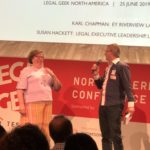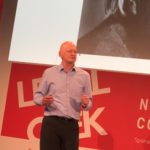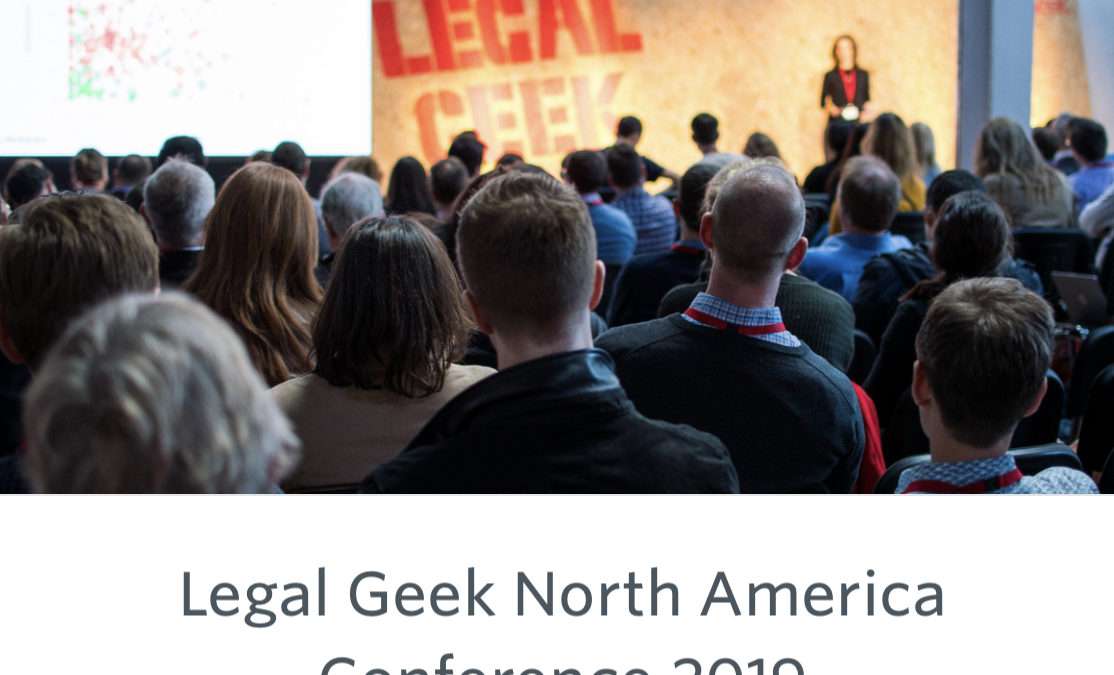Introduction to Legal Geek Opening Sessions
I’m at the Legal Geek North America conference in Brooklyn (on 25 June 2019). It brings together multiple players in legal technology and innovation for a day of rapid fire, 8 to 12 minute, TED-style talks, with a total of 50 speakers in one day.
This is the “Opening Sessions” session, starting at 9:30am. There are eight (8) speakers. .
As is my custom, I live blog some conference sessions. Given the rapid pace and short sessions here, I may not be able to capture each short talk. And normally, I would include links to speakers but doing so here was too daunting given the volume. So some of this may be more impressionistic than my other live blogs. As always with my live posts, please forgive typos and misunderstandings of meaning. I post these as sessions end.
For other posts from this conference, click here.
Opening Sessions Short Talks
Introduction
Jimmy Vestbirk, Legal Geek
Jimmy provides background… he started Legal Geek as part of a process of stranding up a legal tech start-up. He and L/G have roots in San Francisco and NYC though prior conferences have been in London only. Shout outs to Brooklyn Law student volunteers, sponsor Clifford Chance, Thomson Reuters, and Tessian.

Headline talk – Law In The Digital Age
Mark Cohen, Legal Mosaic
Mark calls this conference the Woodstock of legal conferences. And he was at Woodstock! First analogy to Woodstock: wide array of attendees. And it’s not about selling. It’s about being at the conference and sharing ideas. This is new to legal culture. Says this makes the legal industry way more exciting than it was when he started in legal 40 years ago.
Second analogy: it’s not just about the music (though it was great). And it was just another rock concert. It was about a movement, about people looking at the world differently, about people being together, and questioning the mainstream culture and government. At Legal Geek, we celebrate the differences, which is not in keeping with legal market. This conference celebrates the diversity of skills – data analytics, entrepreneurs, for example – who contribute to legal delivery. Law, for a long time, was about legal expertise only. Now, however, it’s about legal, tech, and business expertise – and the integration of those skills. That’s a big difference from even the recent past.
Another big difference is to make law about customers and clients. Contrast that to focus on partner profits, initiated by Steve Brill and the American Lawyers. It should have been and now more about clients and Net Promoter Score. Today, the focus on human resources and tool and creating new models that allow better serving clients. Notes that at most conferences, audience hears from lawyers who say how great they are. Voice of client is missing. Clients look to alternative providers for better client / customer service.

Rethink Talk: European legal industry is going digital + Business Case
Eva Bruch, Alterwork
Mark’s use of “movement” is exactly the right word to describe what’s happening in legal. References LegalZoom as example of new way of delivering legal services. In contitnental Europe, there are different alternatives to law firms. Eva goes through some examples of alts in Europe including KPMG,
Spanish legal market was deregulated 12 years ago. Looking at leading law firms in Spain, top 3 law firms are Spanish national law firms. Next 4 are the Big 4. Baker Mckenzie, Linklaters, and Clifford Chance fill out the top 10. Eva reports that the Big 4 are about efficient delivery. They are more focused on robotic process automation (RPA) than on artificial intelligence (AI). Shares an RPA case study of financial monthly reporting, saving 15 hours per month in each of some 40 lines of business. Important to start with people and process, then go to tech.

From #DoLessLaw to #InvisibleLaw
Jeroen Plink, Clifford Chance
Starts out why he loves Uber because it makes payment frictionless. Compare to paying for a taxi, then expense it. Uber created “invisible process” that improves customer experience and reduces work.
Raiomaze, a tech company, used fact that water inteferes with wifi. Turned that physics fact into alarm system. Another example of using invisible process to detect intruders or someone who has fallen down.
Turns to history of proliferation of law: In the 1980s, creating a contract was tedious with carbon copies and postal services. No one wanted that many contracts. In the 1990s, pace accelerated with word processing, fax, and email. That made lawyers more willing to create documents – and long ones.
#DoLessLaw [with shout-out to me 😉 ] is included in #InvisbleLaw. Examples: (1) companies in NY state have to file semi-annual reports with the state. Most companies are unaware of this and don’t do it. But you can send email to owners and then automate the filings. That removes friction. (2) In Europe, in some jurisdictions, built the speed limit in cars so cars could not go faster than limit. One can extend this to applying fines immediately
Smart contracts make law invisible. By linking milestones to ERP or project management system, one can automatically pay – or apply penalties.
Conclusion: we won’t eliminate lawyers. But we have the potential to change role of lawyers to coding law into systems. Embed the law in systems to make it invisible.

The [R]evolution of Law: Bringing Digital Transformation to the Delivery of Legal Services
Dan Reed, UnitedLex
Transformation is starting and will accelerate. The challenge is to invent to have impact, not just cool experiments. Need to be relevant to people’s lives. That requires real scale – otherwise it won’t make a real difference. Cites Jobs who said “real artists ship”, meaning it’s not enough to have ideas and build, you have to ship product at scale.
Says there is a real revolution in legal now even if you don’t see it. Innovation is nor occurring at scale in law firms. It’s coming from the boards of the biggest companies. Lawyers have lost their immunity to change and business pressure.
Characterizes this revolution as going digital. What does it mean and how does it apply to law? It means total focus on customer and the thinking holistically. Think about value across entire lifecycles. Relates to “value capture.” Unless your solution focuses on this, you won’t be relevant.
To map these ideas to law, you have to look at workflow, training people, and deploying the right tech. With DXC, ULX is forming the digital legal exchange. It is best funded entity of its kind. [ I look forward to opportunity to learn what this is.]

Work done for legal tech associates to embed innovation billable hours
Lucy Dillon, Reed Smith
Reed Smith launched an innovation program in 2016 to improve internal process and work with clients. Initially, there were a lot of great ideas from lawyers but uncertainty about gaining support, having team, and accessing resources to implement. Lawyers face too much pressure to bill hours.
Firm had to find a way to make hours on innovation count toward billable hours. Innovation team proposed to board that attorneys could get full billable credit for some nuner of hours spent on innovation. Board approved a pilot.
Ran seven pilots in 2017. Light touch approval process. 50 hours / year to innovate. At year-end, reported to board. Lucy was nervous some would use this to pad hours – but associates recorded time accurately. With light touch approval, concerned that innovation ideas would be weak – it wasn’t true. Some results did not work but other did. With successes (and some failures), proposed institutionalizing program to board. Proposal was for 2 projects per practice per year but Board said ‘no limit’. There is good flow of projects but not a flood.
Project evaluation now streamlined with straightforward evaluation including revenue potential, complexity, fit with other projects. There are monthly sessions with approved projects to make sure they are on track
Turns out that projects fall into four categories;
- Client innovation projects. Clients sometimes contribute their own team
- Internal efficiency
- Improve knowledge sharing with clients
- Supporting new areas of practice.
Lessons learned: we have serial innovators. Failing is ok. Good distribution of seniority – junior associates, senior ones, and partners.

The higher use of lawyers in a technology enabled function
Susan Hackett & Karl Chapman, Legal Executive Leadership & EY Riverview Law
Start with reference to Paper Chase movie. Susan says this caused her to think about lawyer as “look to left, and look to right” environment.
Could rename movie “The Technology Chase.” We all risk person to left or right inventing tech that will make you irrelevant.
So, what is higher value of lawyers in a new world. It’s not necessarily the years of experience of a lawyer. Indirectly references Innovator’s Dilemma. New entrants come in at the low end. Conversely, too many experience lawyers hang on to low-end work.
Discuss the higher use of lawyers. There is big opportunity to leave operational work to tech or law companies and allow lawyers to focus on strategic value. But no one is defining what that higher use is. When Susan explains impact of tech, lawyers hear “my job is at risk”. To address that, we have to talk about higher value work. This is a leadership question.
It’s not about looking to left or right, it’s about looking up to higher value.

Re-thinking A2J. Inform, Triage, Decide
Chris Bentley, Legal Innovation Zone
We got to the moon but we haven’t got to access to justice (A2J). For moon, President Kennedy set a goal and deadline. We don’t have that with A2J.
Another problem is a focus of process in A2J. Zone focused on solutions to inform legal consumers. And setting a timeline. And decided to launch a family portal by a time definite to force action to create it.

Archives
Blog Categories
- Alternative Legal Provider (44)
- Artificial Intelligence (AI) (57)
- Bar Regulation (13)
- Best Practices (39)
- Big Data and Data Science (14)
- Blockchain (10)
- Bloomberg Biz of Law Summit – Live (6)
- Business Intelligence (21)
- Contract Management (21)
- Cool Legal Conferences (13)
- COVID-19 (11)
- Design (5)
- Do Less Law (40)
- eDiscovery and Litigation Support (165)
- Experience Management (12)
- Extranets (11)
- General (194)
- Innovation and Change Management (188)
- Interesting Technology (105)
- Knowledge Management (229)
- Law Department Management (20)
- Law Departments / Client Service (120)
- Law Factory v. Bet the Farm (30)
- Law Firm Service Delivery (128)
- Law Firm Staffing (27)
- Law Libraries (6)
- Legal market survey featured (6)
- Legal Process Improvement (27)
- Legal Project Management (26)
- Legal Secretaries – Their Future (17)
- Legal Tech Start-Ups (18)
- Litigation Finance (5)
- Low Cost Law Firm Centers (22)
- Management and Technology (179)
- Notices re this Blog (10)
- Online Legal Services (64)
- Outsourcing (141)
- Personal Productivity (40)
- Roundup (58)
- Structure of Legal Business (2)
- Supplier News (13)
- Visual Intelligence (14)

